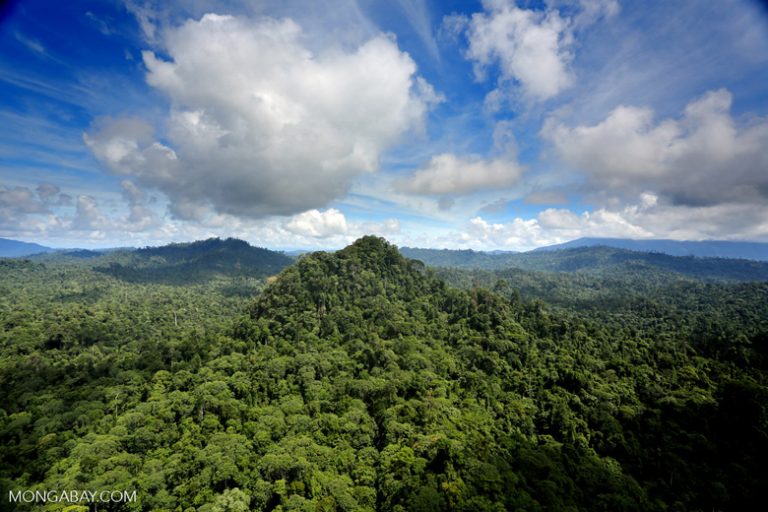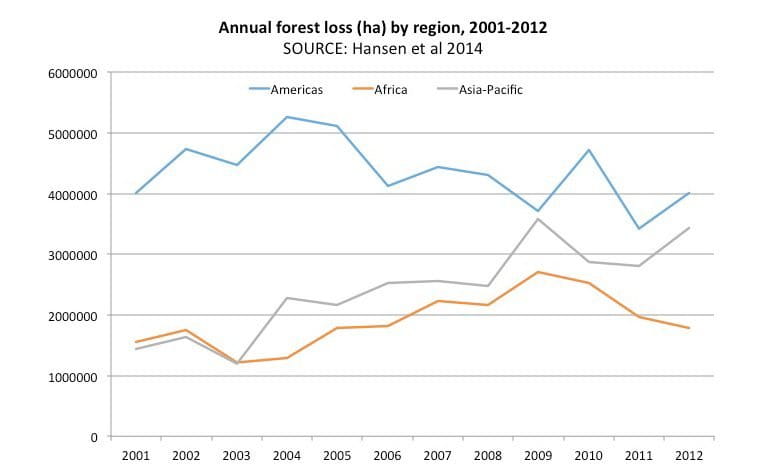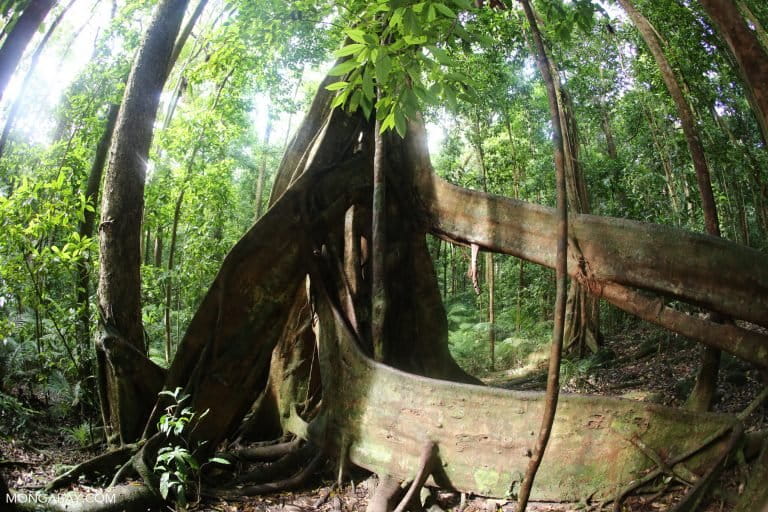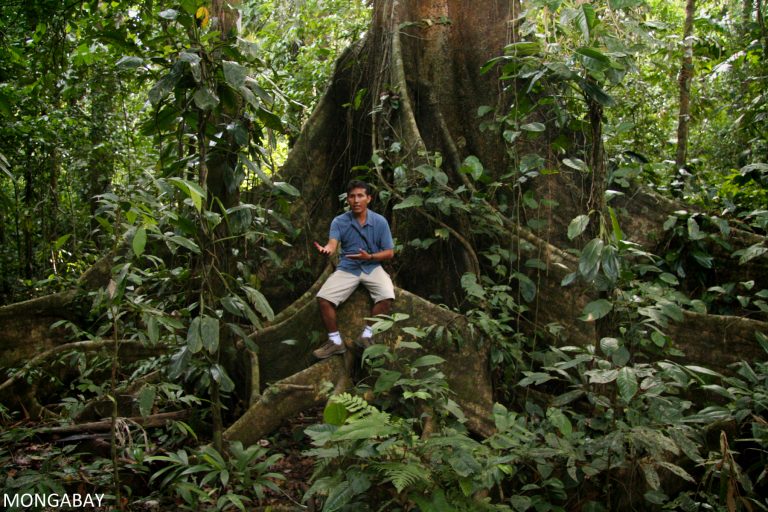- In the 1990s, the world watched with alarm as vast tracts of tropical rainforest were torn down for timber and croplands, dug up for minerals and energy, and flooded for hydroelectric projects.
- Conservation groups, governments, philanthropists, and institutions like the World Bank collectively spent billions of dollars on programs to stop the carnage.
- But as viewed from satellites high above Earth’s surface, those efforts barely dented deforestation rates.
Note: this is the first draft of a commentary I submitted to Yale Environment 360 last month. A final first-person version is available at A Conservationist Sees Signs of Hope for World’s Rainforests.

In the 1990s, the world watched with alarm as vast tracts of tropical rainforest were torn down for timber and croplands, dug up for minerals and energy, and flooded for hydroelectric projects. Conservation groups, governments, philanthropists, and institutions like the World Bank collectively spent billions of dollars on programs to stop the carnage. But as viewed from satellites high above Earth’s surface, those efforts barely dented deforestation rates. Nearly a decade and a half into the 21st century, the world is still witnessing the same destruction, albeit at a slightly reduced rate.
Yet despite this apparent stasis, there are reasons to believe that progress is being made in efforts to preserve tropical forests. Underpinning this progress are economic trends and technologies that make it easier than ever before for environmentalists and others to target drivers of deforestation. These are in turn, spawning the emergence of new leaders who are adopting, implementing, and conceiving new policies for arresting deforestation. At the same time, the world is finally starting to recognize the value of services afforded by healthy ecosystems and the contributions make by local and indigenous communities in keeping forests standing.

Tropical forest loss has remained at stubbornly high since the 1990s, declining from an average of 11.3 million hectares during the decade to roughly 9.3 million hectares per year between 2009 and 2012. Ranking at the top during both periods were the usual suspects: Brazil and Indonesia, both of which have extensive forest cover and surging agribusiness sectors.
But hidden in these high level numbers is a trend that holds important implications for efforts to conserve the world’s forests. Today forests are more often cleared to produce commodities for consumption in urban markets and for trade, rather than for subsistence by poor slash-and-burn farmers. In other words, the tropics are shifting from poverty-driven to profit-driven deforestation.

This trend is significant because today there are fewer entities doing a greater share of damage to forests. Two generations ago, combatting deforestation meant devising ways for burgeoning rural populations to feed themselves without chopping down forests for agriculture. Today, more often than not, it means persuading companies and governments to adopt safeguards that limit environmental damage but ultimately enable them to keep growing crops. In some cases these measures may yield beyond the public relations gains of green marketing and corporate social responsibility programs, in the form of gains from improved supply chain management and operational efficiency.
Most companies however don’t move on their own—they are pushed, often by consumer-focused campaigns led by environmental groups, which leverage corporations’ sensitivity to criticism. The results since 2006 have been nothing short of astounding: dozens of the world’s largest buyers and sellers of soy, palm oil, cattle, and wood pulp have established policies committing them to excluding deforestation—and social conflict—from their supply chains. The biggest coup came last month when Cargill, which sells $135 billion worth of commodities a year, committed to zero deforestation across all its supply chains.
And while there is always a danger of backsliding or cheating on these commitments, there are more tools than ever before to monitor and verify compliance.

At the highest level, satellite imagery is widely available and is increasingly incorporated into monitoring systems. For example, the Brazilian government and the Roundtable on Sustainable Palm Oil (RSPO), an eco-certification body, are now requiring “shape files” that detail the coordinates of landholdings. This data can be used to determine compliance with environmental regulations and standards.
Satellite data is also integrated into platforms developed by civil society. The best example is Global Forest Watch, a project led by World Resources Institute that takes data from a range of sources and puts it on a map, providing unprecedented insight into the state of the world’s forests, including tree cover gain and loss, forestry concessions, and fire history. Its integration of bi-monthly MODIS data provided by NASA enables the platform to serve as a near-real-time deforestation detection system, similar to that implemented by Brazil about the time its deforestation rate began to plunge dramatically in the mid-2000s. A study published last year by the Climate Policy Initiative attributed three-fifths of that decline to Brazil’s monitoring system. Now that functionality is global.

Closer to the ground, capabilities are also improving. Many observers believe the world is on the verge of a drone revolution, with conservationists hoping that monitoring by small aerial drones will greatly improve the detection of deforestation, including detecting deforestation, illegal logging, fire, and poaching that would otherwise be missed by satellites. Advocates say drones could complement on-the-ground efforts by spotlighting places that need follow-up by authorities, as is the approach being used in a pilot project in Nepal’s Chitwan National Park.
On the ground, camera traps, sensors, and ubiquitous mobile devices are enabling new approaches to monitoring. For example, RainforestConnection, a California-based startup, has developed a mobile phone-based system that “listens” for gunshots, chainsaws, and trucks. When a suspicious sound is detected, the system relays an alert to local authorities, enabling action just minutes after detection. New innovations in DNA analysis are allowing investigators to trace timber products back to their points of origin, potentially determining their legality.

These tools enable law enforcement, but whether action is taken hinges on political will. In the past, this has been far from assured, but that may be changing too.
Last month more than two dozen countries endorsed the New York Declaration on Forests, pledging to halve deforestation by 2020 and end it by 2030. While critics note that high-level pledges don’t mean a whole lot, some countries are actually taking concrete steps to address deforestation. Leading the way is Brazil. Since 2004 the nation with the world’s most tropical forest has cut annual deforestation in its Amazon region by nearly 80 percent. At the same time, agricultural output increased sharply, putting to rest the assumption that deforestation and economic growth move in tandem. Establishing new protected areas, enforcing environmental laws, and private sector measures all played a part in the decline, prevented 3.2 billion tons of carbon dioxide emissions, equivalent to removing all cars from America’s roads for three years, according to a paper published in Science in June.

There are even signs of progress in Indonesia, an environmental pariah for the better part of two decades due to large-scale forest destruction. After pledging in 2009 to drastically reduce greenhouse gas emissions from a projected 2020 baseline, in 2011 then-president Susilo Bambang Yudhoyono established a moratorium for new logging and plantation permits across more than 14 million hectares of previously unprotected peatlands and forests. The move was accompanied by a push to reform the bureaucracies that manage the country’s forests. Those efforts were fiercely resisted by entrenched interests in the forestry sector, which have historically fought for policies that enable industrial logging and forest conversion, often at the expense of local communities. But that paradigm might be changing. Last month, a handful of palm oil companies with substantial operations in Indonesia—Golden Agri-Resources, Cargill, and Wilmar—signed the KADIN Pledge calling upon the Indonesian government to adopt policies that support forest conservation. a law that aims to impose fines on companies—foreign and Singapore-based—deemed responsible for causing haze in neighboring Indonesia.

Some small countries are even further ahead. Costa Rica pioneered the development of payments for ecosystem services in the 1990s and is widely viewed as a leader when it comes to developing business models around keeping forests standing. In so doing, the country has moved from an extraction-based economy to a more lucrative service-based economy. Mexico has turned vast areas of forest over to local community control, buffering forest cover in areas that previously suffered from high rates of loss.
Change is not just happening at the national level. Several states and provinces have pledged to substantially reduce deforestation by 2020 under the Governors’ Climate and Forests Task Force, an initiative that aims to establish protocols for state-to-state carbon trading. These commitments are underpinned by programs that aim to develop jurisdiction-based certification systems, under which all producers in a given municipality or state abide by environmental standards to ensure that commodities produced within its borders are “safe” for international buyers.

Even more locally, there is growing recognition of the role communities play in maintaining forest cover. Research published earlier this year by World Resources Institute and the Rights and Resources Initiative concluded that community-managed forests experienced an average deforestation rate that is 11 times lower than land outside their borders. Legally-recognized community-managed forest amounts to 513 million hectares or an eighth of the world’s forests.
And that area may be about to expand. Last year Indonesia’s Constitutional Court invalidated the Indonesian government’s claim to millions of hectares of forest land, ruling that indigenous and local communities have the right to manage their customary forests. The decision is significant because the central government currently controls the country’s forest estate, enabling it to grant large logging and plantation concessions even in forests that have been managed—and kept standing—by local people for generations.
Some indigenous groups are even looking at new business models that would allow them to earn livelihoods while doing what they always did—preserve forests—through nascent payments for ecosystem services or taking over management of conservation areas.

Payments for ecosystem services is another important development for the world’s forests. While a market for forest carbon under the U.N. Reducing Emissions from Deforestation and Degradation (REDD+) mechanism has been slow to materialize, it nonetheless indicates that the world is starting to pay attention to the services afforded by healthy ecosystems. These aren’t limited to carbon—forests provide water, help mitigate erosion, house biodiversity, and offer option value like diversified income streams relative to monocultures. Old-growth forests in particular are getting more attention as a conservation priority, being off-limits to conversion under zero deforestation commitments and with growing pressure from advocates to exclude them from exploitation under environmental certification initiatives like the Forest Stewardship Council (FSC).
But while there are things to be optimistic about when it comes to protecting tropical forests, plenty of risks lie on the horizon. Continued population growth and surging consumption will stretch the planet’s resources, increasing pressure on ecosystems like forests. Solutions that could boost productivity of existing agricultural lands and degraded areas—for example intensification through increased use of chemicals and genetically modified organisms, and abandonment of wildlife-friendly approaches to land management like organic farming—may prove too controversial for some. There’s also a real risk that consumers won’t continue to care about the environmental credentials of products, especially as global consumption shifts from West to East. Finally a failure to address climate change could leave forests severely degraded or worse off whether or not they are protected. Already scientists have detected large-scale die-offs from droughts in parts of the Amazon, a scary preview of what could lie ahead. All optimistic bets are off if the world fails to confront these challenges.

| SAVING RAINFORESTS: | ||
|
5 reasons to be hopeful
|
And 5 reasons to be pessimistic
|
|